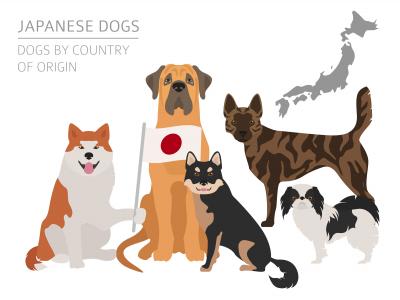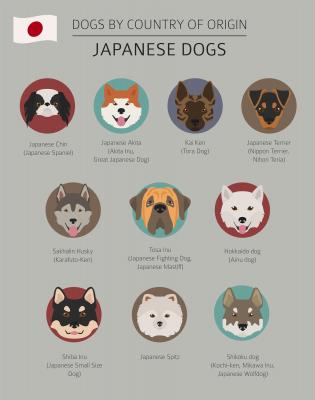Shikoku Dog: An In-Depth Guide for Enthusiasts

The Shikoku dog, originating from the mountainous parts of Japan’s Shikoku Island, is a fascinating breed of dog. As one of the six native Japanese dog breeds, this medium-sized canine boasts an illustrious history as traditional hunters and revered companions.
In our comprehensive guide to this unique breed, we’ll delve into their origins and physical characteristics. We’ll explore how these Japanese wolfdogs have gained recognition from various kennel clubs worldwide and their global distribution.
We will also shed light on their temperament and trainability – highlighting their interaction with owners and socialization needs. Additionally, we’ll discuss important aspects such as nutritional requirements & exercise routines for your shikoku dogs to ensure they lead healthy lives.
From grooming essentials for maintaining their thick fur to potential health concerns in the breed – every aspect will be covered meticulously. Finally, you can look forward to learning about the suitability of these intelligent creatures around kids & other animals along with their roles as protection or service dogs.
Table of Contents:
- Shikoku Dog – An Overview
- Popularity and Distribution of the Shikoku Dog
- Temperament & Trainability of a Shikoku Dog
- Nutritional Requirements & Exercise Routine
- Grooming Your Shikoku Pup: Tips and Tricks
- Health Concerns in a Shikoku Breed
- Suitability Around Kids And Other Animals
- Role as Protection or Service Dogs
- FAQs in Relation to Shikoku Dog
- What is the purpose of the Shikoku dog?
- Is a Shikoku a good family dog?
- How long do Shikoku dogs live?
- Are Shiba Inu and Shikoku dogs related?
- What are some other dog breeds not related to the Shikoku?
- Can you share a personal experience or anecdote about Shikoku dogs?
- Why is it important to avoid irrelevant information outside of the topic?
- Conclusion
Shikoku Dog – An Overview
The Shikoku dog is a medium-sized spitz breed from Japan’s mountainous region. This impressive canine was initially recognized as Tosa Ken due to its muscular build, pointy ears, and thick double coat that sheds heavily once or twice a year.
Origin of the Shikoku Dog
This breed hails from the rugged terrains of Shikoku Island. It was bred for hunting wild boars and deer in this harsh environment. The isolation of the island led to limited crossbreeding, resulting in a pure line that has been preserved over centuries.
Physical Characteristics
- Size: Medium-sized with males standing 20-22 inches at shoulder height while females are slightly smaller.
- Chest: Deep chest allowing ample room for lungs, aiding their stamina during hunts.
- Fur: Thick double-coat that comes in sesame (black-tipped hairs on a rich red background), black & tan, or cream colors.
- Eyes: Slanted eyes giving them an alert expression with color ranging from dark brown to nearly black.
Their unique physical characteristics combined with their agile nature make them excellent companions for active individuals who enjoy outdoor activities like hiking or jogging.
Popularity and Distribution of the Shikoku Dog
The Shikoku dog, despite its unique characteristics and rich history, is not as well-known globally compared to other breeds. It’s a breed that has managed to retain its original traits due to geographical isolation on Shikoku Island, where it originates from.
Recognition by Various Kennel Clubs
The AKC has yet to give the breed official recognition, but it is classified within the hound group by the CKC. However, in Canada, they are classified within the hound group by the Canadian Kennel Club (CKC). This classification reflects their innate hunting prowess which was honed over centuries for tracking game in mountainous terrains.
Global Presence
The global presence of Shikokus remains limited but growing steadily since the late 1960s and early 1970s when these dogs were first imported into Western Hemisphere countries. Today, you can find them scattered across various parts of North America and Europe with dedicated owners who appreciate their loyalty and intelligence.
This rare Japanese breed certainly deserves more attention considering its distinctive features such as high prey drive, making them effective protection dogs with appropriate training. As potential pet owners get familiarized with this special canine companion’s needs – be it nutritional or grooming – we hope to see an increase in their popularity worldwide.
Temperament & Trainability of a Shikoku Dog
The Shikoku dog is a fascinating breed that can make a great companion for active owners. They’re calm and adventurous outdoors, but quiet and well-behaved indoors. These canines are extremely devoted to their owners, yet they may become hostile if not trained correctly.
Bonding with Owners
A well-socialized Shikoku dog will form a strong bond with its owner, showing both respect and affection. However, this breed requires firm leadership from its family to ensure good behavior.
Socialization Needs
Early socialization is crucial for Shikoku dogs to adapt well to different environments and people. This includes exposure to various sounds, sights, experiences, humans, and other animals from a young age, which helps shape them into well-rounded pets.
When it comes to training, Shikoku Ken dogs are intelligent and eager to please their masters, making them highly trainable. However, it’s important to use positive reinforcement methods such as treats or praise rather than harsh corrections or punishments. Check out Cesar’s Way for some great tips on how to effectively train your Shikoku pup.
Nutritional Requirements & Exercise Routine
As a modern-day Shikoku dog owner, you need to ensure that your furry friend is getting the right nutrition and exercise to keep them healthy and happy. These energetic creatures require a balanced diet that includes proteins, fats, vegetables, fruits, and whole grains. To make sure you’re feeding your pup right, consult with a veterinary nutritionist before making any major changes to their meal plan.
Dietary Needs
High-quality dry kibble, raw or cooked meats, and a variety of fruits and veggies can help keep your Shikoku dog in top shape. A balanced diet is essential for preserving the health and vigor of a Shikoku dog.
Regular Exercise Regime
Shikoku dogs are tough and agile creatures that require regular physical activity to stay healthy. Daily walks or runs, playtime in the yard or park, and mentally stimulating activities like agility training can help channelize their energy effectively. Wondering how much exercise your dog needs every day?
Remember, it’s essential to ensure your Shikoku pup receives a balanced amount of exercise and nutrition for their overall health. So, keep them active, feed them right, and enjoy the company of your furry friend.
Grooming Your Shikoku Pup: Tips and Tricks
Keeping your Shikoku dog looking great doesn’t have to be a hassle. Brushing regularly can help maintain your Shikoku pup’s coat in good condition, providing it with a glossy and healthy look. Here are some grooming essentials you should know:
Brushing Your Shikoku
Brushing your Shikoku’s coat is essential to keep it looking great. Brush at least once a week to remove loose hair and distribute natural oils evenly. This will help keep your pup’s coat healthy and shiny.
Bathing Your Shikoku
Shikokus don’t require frequent baths, but you should bathe them every few months. Over-bathing can strip away essential oils from their skin, leading to dryness or irritation.
Other Grooming Tips
Don’t forget about other aspects of grooming, such as nail trimming, ear cleaning, and dental hygiene. Check your pup’s ears regularly for signs of infection, brush their teeth weekly, and trim their nails every 3-4 weeks if they don’t wear down naturally.
By following these grooming tips, you can keep your Shikoku pup looking and feeling their best. Remember, consistency is key when it comes to grooming routines.
Health Concerns in a Shikoku Breed
The Shikoku breed is generally healthy, but like any other dog breed, they can be prone to certain health issues. It’s important for owners to be aware of potential problems that may arise.
Epilepsy
Epilepsy is a neurological disorder that can cause seizures in Shikokus. It requires lifelong management through medication and regular vet check-ups.
Allergies
Shikokus are also prone to allergies, which could be caused by certain foods or environmental factors like pollen or dust mites. Keep an eye out for symptoms such as excessive scratching, skin irritation, or gastrointestinal issues.
Kneecap Dislocation
Kneecap dislocation, also known as patellar luxation, is a genetically linked condition seen in some Shikokus. It can cause pain and mobility difficulties for the dog.
Regular veterinary visits and proper care can help your Shikoku lead a happy and healthy life.
Suitability Around Kids And Other Animals
The Shikoku dog is intelligent and obedient, making them a joy to train. However, their aggressive tendencies towards unfamiliar animals make their suitability in homes with other pets or young children questionable. Their strong hunting instincts may surface when encountering smaller pets or reacting defensively around boisterous kids.
Potential owners must understand the importance of compatibility before bringing a Shikoku dog home. The environment should be calm and controlled, allowing the dog to feel secure and less threatened.
If you have other pets at home, consider how they might interact with a new Shikoku pup. Similarly, if you have young children who are not yet familiar with handling dogs appropriately, it might pose challenges as well.
In cases where there are existing household pets or younger family members involved, professional training advice could prove beneficial in managing any potential issues that may arise during integration. Sites such as Cesar’s Way offer helpful tips on introducing new dogs into your home effectively.
Role as Protection or Service Dogs
The Shikoku dog’s traditional role as a hunter and their high prey drive make them effective candidates for protection dogs. However, these traits require extensive training to channelize appropriately. The breed’s loyalty and intelligence could potentially qualify them as service dogs too, but again rigorous training is required to ensure behavior control.
Training a Shikoku dog for protective roles involves honing their natural instincts while also teaching them restraint. This can be achieved through professional obedience training, which helps in managing their aggressive tendencies effectively.
As potential service dogs, the key lies in utilizing their innate intelligence and adaptability. Training programs like Assistance Dogs International (ADI)‘s public access test can help determine if your Shikoku has what it takes to serve those with disabilities or other special needs.
It’s important to remember that not all Shikokus will excel in these roles – much depends on individual temperament and aptitude. Therefore, professional assessment is recommended before embarking on such intensive training programs.
In both cases – whether as protection or service dogs – commitment from the owner towards regular and consistent training sessions is crucial for success.
FAQs in Relation to Shikoku Dog
What is the purpose of the Shikoku dog?
The Shikoku inu was bred for hunting in mountainous regions, making them intelligent and effective hunters that can also serve as protection dogs.
Is a Shikoku a good family dog?
While Shikokus can be loyal and affectionate with their families, their high prey drive and independent nature may make them better suited for experienced dog owners.
How long do Shikoku dogs live?
On average, Shikokus live for 10-12 years.
Are Shiba Inu and Shikoku dogs related?
Yes, both dog breeds are native to Japan and are believed to share a common ancestor, but they are distinct breeds with different characteristics.
Conclusion
If you’re looking for a loyal and affectionate companion, shikoku dogs are a great choice. This type of Japanese breeds is known for their intelligence and athleticism, making them perfect for active owners. So, if you’re considering getting a shikoku dog, do your research and make sure you’re ready for the commitment.
And remember, owning a dog is a big responsibility, but the love and companionship they provide is worth it.
